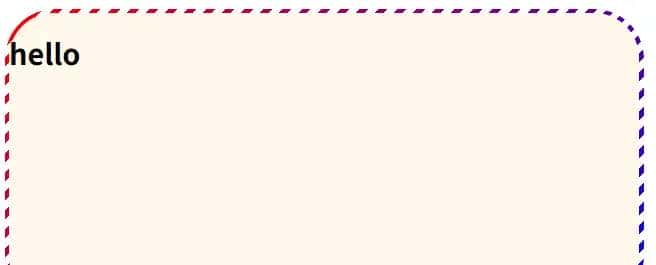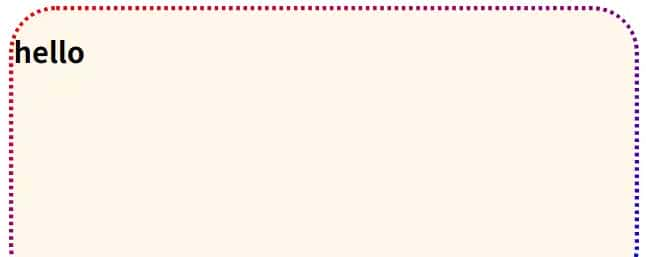border 圆角渐变边框,实现方式

方式 1
<div class="border"><h1>hello</h1></div>
.border {
--border-width: 5px;
--rounded: 50px;
width: 700px;
height: 320px;
position: relative;
background: #fff7eb;
border-radius: var(--rounded);
}
.border::before {
content: ;
background: linear-gradient(135deg, red, blue);
position: absolute;
top: calc(0px - var(--border-width));
right: calc(0px - var(--border-width));
bottom: calc(0px - var(--border-width));
left: calc(0px - var(--border-width));
border-radius: calc(var(--rounded) + var(--border-width));
z-index: -1;
}
方式 2
.border {
--border-width: 5px;
--rounded: 50px;
width: 700px;
height: 320px;
border: var(--border-width) solid transparent;
border-radius: var(--rounded);
background:
linear-gradient(#fff7eb, #fff7eb) padding-box,
linear-gradient(135deg, red, blue) border-box;
}
border 圆角渐变虚线边框,实现方式1
适应性比实现方式2更强,在边框足够细的时候,左上角和右下角的这种残缺效果会被弱化。
不适合做粗边框

<div class="border2"><h1>hello</h1></div>
.border2 {
--border-width: 5px;
--rounded: 50px;
--border-dot-line: calc(2px + var(--border-width));
width: 700px;
height: 320px;
position: relative;
background: #fff7eb;
border-radius: var(--rounded);
}
.border2::before {
content: ;
background: linear-gradient(135deg, red, blue);
position: absolute;
top: calc(0px - var(--border-width));
right: calc(0px - var(--border-width));
bottom: calc(0px - var(--border-width));
left: calc(0px - var(--border-width));
border-radius: calc(var(--rounded) + var(--border-width));
z-index: -1;
-webkit-mask: repeating-linear-gradient(
-45deg,
black 0,
black calc(var(--border-dot-line)),
transparent calc(var(--border-dot-line)),
transparent calc(var(--border-dot-line) * 2 + 1px)
);
}
border 圆角渐变虚线边框,实现方式2
使用 SVG 实现,比方式1要更好
但是比方式1控制起来要复杂一些。当页面动态变化的时候,可能需要重新计算一些东西

<div class="border3">
<svg class="svg-content" viewBox="0 0 100% 100%" preserveAspectRatio="none">
<!-- 边框渐变颜色 -->
<defs>
<linearGradient id="strokeGradient" x1="0%" y1="0%" x2="100%" y2="100%">
<stop offset="0%" stop-color="red" />
<stop offset="100%" stop-color="blue" />
</linearGradient>
</defs>
<!-- 边框线条样式 -->
<!-- stroke-dasharray 虚线长度。前一个数组是有颜色的长度,后一个数字是空白长度 -->
<!-- x, y 需要设置为线条宽度的一半 -->
<!-- stroke-width 线条宽度 -->
<rect
class="svg-rect"
stroke-dasharray="4,4"
stroke-opacity="1"
x="2.5"
y="2.5"
rx="50px" ry="50px"
style="fill: transparent; stroke-width: var(--border-width); stroke: url(#strokeGradient);"
/>
</svg>
<div class="border3-wrapper">
<h1>hello</h1>
</div>
</div>
.border3 {
--border-width: 5px;
--rounded: 50px;
width: 700px;
height: 320px;
position: relative;
overflow: hidden;
}
.border3-wrapper {
content: ;
position: absolute;
top: 50%;
left: 50%;
right: 0;
bottom: 0;
transform: translate(-50%, -50%);
width: calc(100% - var(--border-width) * 2);
height: calc(100% - var(--border-width) * 2);
border-radius: calc(var(--rounded) - var(--border-width));
background: #fff7eb;
}
.svg-content {
z-index: -1;
position: absolute;
top: 0;
left: 0;
width: 100%;
height: 100%;
}
.svg-rect {
width: calc(100% - var(--border-width));
height: calc(100% - var(--border-width));
}
© 版权声明
文章版权归作者所有,未经允许请勿转载。
相关文章

暂无评论...












